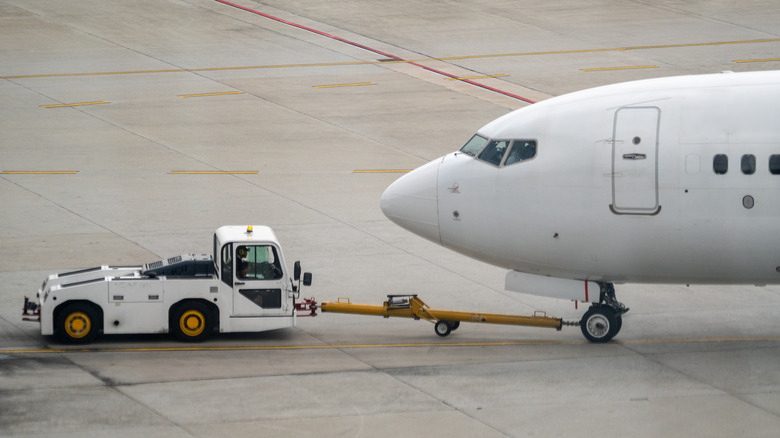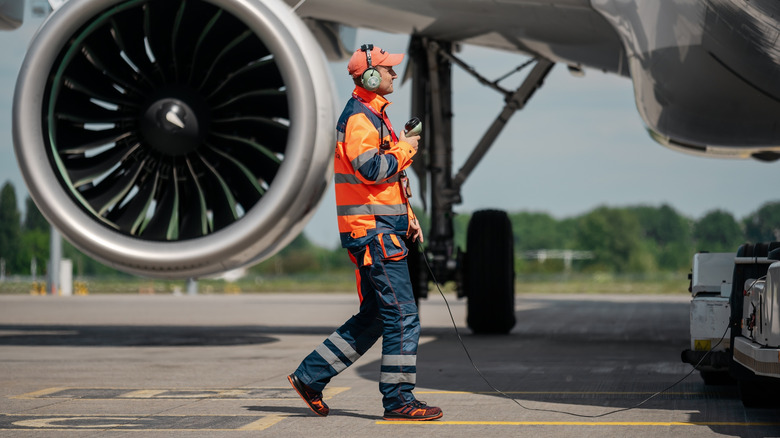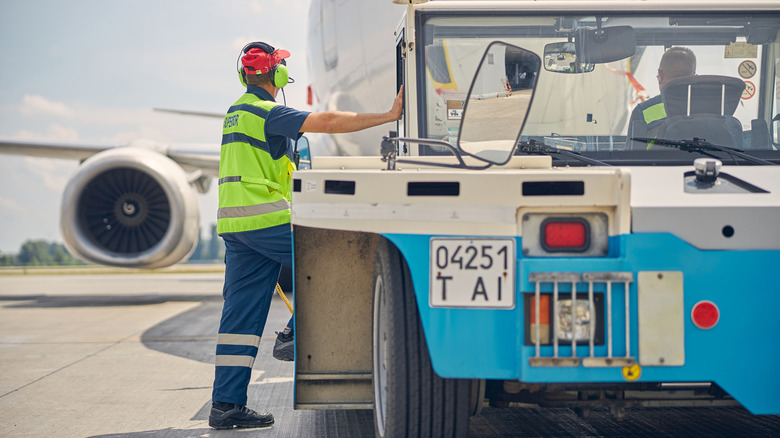Why Do Airplanes Need To Be Pushed Back By Tugs Before Takeoff?
If you think backing your truck out of a parking spot without a reversing camera is hard, imagine reversing away from a crowded airport gate in a 400-ton airplane, with not a rear view mirror in sight. While passenger planes are very good at going forward through the air very quickly, they are not so good at going backwards on the ground. Those wheels on the end of the landing gear? They can roll, steer and brake — but they cannot motor the plane around the way wheels on a road vehicle do.
A commercial aircraft pilot could, in theory, back a plane onto a taxiway using reverse thrust, the same mechanism that rapidly slows a plane to taxi speed after landing. But in practice, using reverse thrust would be extremely loud, uneconomical, and dangerous. Thankfully, the same people who made airplanes the safest way to travel have thought this problem through, taken a leaf out of the cargo ship handbook, and come up with a better option – the pushback tug.
Also known as a pushback tractor or tow tractor, these large, heavy, high-torque vehicles, with their oversized wheels and tow hooks, play a highly specialized role in airport logistics. Apart from pushing planes safely back onto the tarmac, where they can taxi along under their own power, tugs also tow aircraft in and out of maintenance hangars, where airplane engines generally cannot be used because of the dangers they pose to equipment and personnel.
Safety is high priority at the airport
High on the list of things airline pilots wished passengers knew about their jobs is the sheer number of staff needed to get planes into the air. Ground crew — air marshals, baggage handlers, ramp agents, maintenance workers, wing walkers, and drivers — must be kept safe and out of the line of fire of jet engines., which is why airports usually only allow pilots to apply thrust in "break-away areas"where it is safe to do so.
Jet efflux — the scalding hot exhaust blasting out of the engine at more than 375 mph — is a significant hazard, even hundreds of feet away. In one case, the jet blast of a taxiing Boeing B748 blew the windows out of a bus on the tarmac, showering its passengers with broken glass. Even 200 feet from the airplane, jet efflux can hit 150 mph, the speed of a category five hurricane. When deploying the reverse thrusters, that efflux is redirected towards the front of the aircraft — which could mean towards a terminal building, another aircraft, ground crew, or even passengers.
In the congested space of an airport, there is the further risk posed by FOD, or foreign object debris, being ingested into a jet engine. FOD can include tools, fragments of tarmac, wildlife, catering equipment, rocks, luggage, and the damage it can cause is another reason airplanes are pushed back onto the taxiway, rather reversing under their own power.
Plenty of pushback: the job of a tug operator
Apart from the deafening noise and the danger, maneuvering a jet on the ground using its engine thrust is uneconomical, given the huge amount of jet fuel a commercial airplane burns compared to a pushback tug or tow tractor. While traditionally gas or diesel-powered, some newer pushback tugs are powered by batteries, with electric motors offering instant torque, precision, quieter operation, lower maintenance, and less operating costs.
In the early days of aviation, when airplanes landed in open fields, pilots would commandeer the nearest farm tractor to hook up their plane and move it around, hence, so the story goes, a pushback tug is also known as a tow tractor. Sharing more than a few similarities with its marine counterpart, a powerful pushback tug can, despite its name, either push or pull the object under tow, using its weight — sometimes more than 30 tons — to apply traction to its large tires.
Some pushback tugs attach towing hooks to the aircraft's landing gear, while others use a hydraulic lift to take the weight of the plane, again helping with traction. Once hooked up, the pilot gives the go-ahead, and the tug operator steers the plane onto the taxiway, the strip of tarmac connecting the aircraft stand to the runway. The pilot signals to disengage, and, with the tug safely out of the way, commences the carefully coordinated set of procedures that will hopefully lead to an in-flight service trolley at 30,000 feet.


